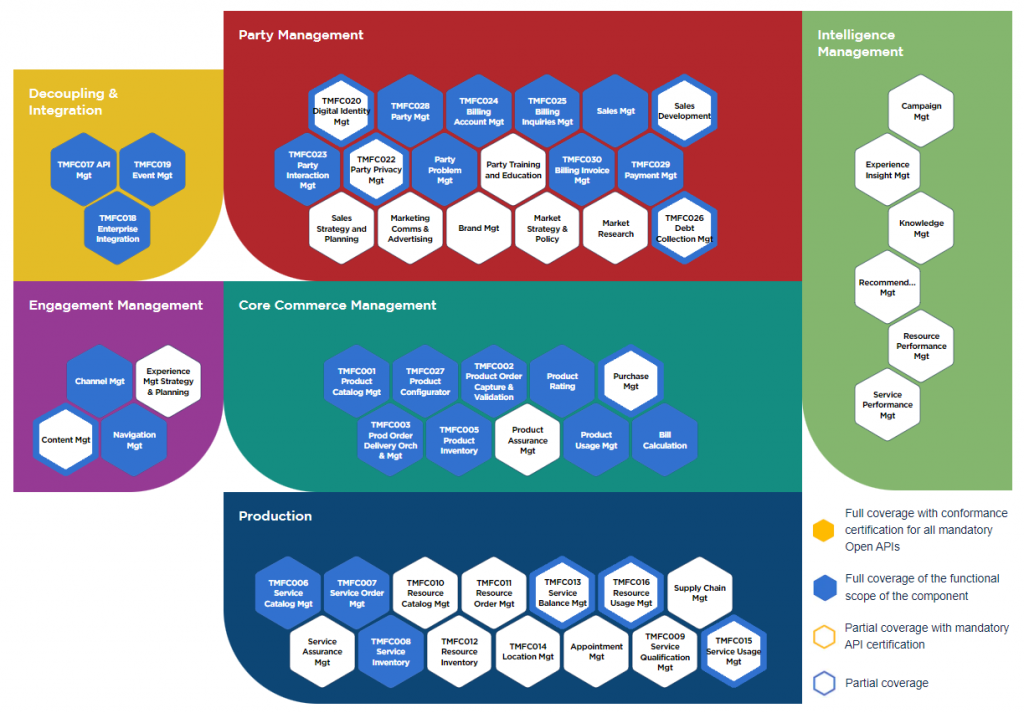
Merima Žiko
Product Manager
Open Digital Framework (ODF) and Open Digital Architecture (ODA) are already transforming the communications sector, with several big operators across the globe now running on ODA. Why? One big advantage of the approach spearheaded by TM Forum is the way it facilitates practical implementations.
TM Forum and its members acknowledge that in a multi-party ecosystem, there are no single players. No one-stop-shop answer to implementing the technologies they need. Instead, they require a best-of-breed shopping mall. Something that ODA provides with simple and easy-to-integrate modules, mapped onto a cloud-native blueprint.
In this blog, Merima Žiko, Product Manager at ZIRA, details what implementation looks like.
Understand what ODA and ODF are, and find out more about the benefits, in Merima’s previous blog, Open Digital Architecture: Streamlining through standardization.
Navigating the component directory
One starting point for exploring an ODA-based approach is the component directory. This gives a birds-eye view of all elements of the digital ecosystem, broken down into components. CSPs can access an overview of the components in general and also look specifically at the components each ODA vendor offers. You can see here and in the below diagram what this looks like using ZIRA, as an example.

The component directory gives several benefits for both the customer and the vendors designing ODA modules.
- It helps CSPs easily browse and search for specific components with clarity on what each solution will deliver.
- It lists vendors with commercial products that cover the functional scope of the components. By clicking on a specific product, CSPs can see its details and certification level, making it easy to identify the solutions that best serve their business needs.
- It allows for clearer RFPs, with ODA providing a convenient framework to aid the procurement of any element of the digital ecosystem a CSP needs to integrate or replace.
Additionally, the component directory allows practical migration. Vendors can certify APIs running in the real world with their service provider customers. This offers two benefits. It allows CSPs to migrate elements of their existing infrastructure to the ODA model. At the same time, they know the solutions deliver, not just in the product lab but in live-operated deployments.
Many ZIRA customers already use open APIs that can function as part of ODA. Others using older frameworks like SID and eTOM can work with ZIRA to easily migrate to ODA-compatible solutions, making it a pragmatic approach to ecosystem evolution.
Looking in detail at ODA components
We have seen the structure and benefits of the component directory. Now, let’s take a deeper dive into exactly what Open Digital Architecture components look like. It’s then that we can really start to understand how this helps CSPs build an effective digital ecosystem.
The ODA framework defines the various components of a digital architecture. It visualizes them in a way that clearly defines the scope of each module, and how it interfaces and interacts with other elements of an open digital ecosystem. This allows for a clear understanding of the structure, relationships, and dependencies of the different elements involved in their digital architecture. TM Forum members, like ZIRA, are actively working to mature these component specifications. This is to ensure complete compatibility and interoperability among ODA vendors and realize the vision of a single universal ecosystem.
Determining how the ODA framework defines the different components breaks down into the following steps:
- Identify the components: ODA splits elements of the digital ecosystem into components or modules. Part of the process of defining what ODA looks like is to determine the boundaries of each component. This gives CSPs and vendors a blueprint for how services and products should be segmented.
- Define the scope: The next phase identifies what the scope of each module looks like. This includes its applications, databases, APIs, microservices, and other relevant elements. Each component or module should represent a distinct functionality or capability that is clearly defined.
- Determine interfaces: With the scope and capabilities of each module defined, the next step outlines how the modules will connect or interface. ODA prescribes how modules should interact, for example, via open APIs, and outlines how data flows should work. This allows interoperability and CSPs to build an entire ecosystem with different vendors working seamlessly together.
- Show dependencies: The natural follow-on to the interfaces is to identify and provide guidance for components that rely on data from another, as well as functional dependencies. By identifying and building a framework to cope with them, ODA is fit for purpose in real-world scenarios.
The result is the blueprint that splits the ecosystem into clearly defined modules. They are given levels of certification to demonstrate how they work within ODA and expressed on an easy-to-understand map that enables CSPs to effortlessly engage with vendors. Each vendor will have its key strengths, for example, ZIRA is particularly strong in delivering business partner, product management, and customer management solutions. Allowing CSPs to mix and match best-in-class solutions, from a variety of vendors, each playing to their strengths, is one of the real advantages of ODA.
Why work with ZIRA
At ZIRA, we have not only been working to ensure that our BSS solutions operate within the context of the ODA framework, but we have also been part of the consortium that has defined the approach. This means customers migrating to an ODA and working with ZIRA have the map, plus a knowledgeable tour guide for the ecosystem.
We have a long track record of helping customers overhaul their software systems, driving efficiency and growth. Working within the ODA model, we can further reduce the complexity and time to market for our customers and implement best-in-class elements that will move the needle for their operations.
We specialize in business support systems, including Customer Partner Management, Product Catalog, Order Management, Trading and Routing, Billing, and Revenue Management solutions. By ensuring our solutions for these areas fit with the ODA framework, we can streamline the full lead-to-cash process for retail and wholesale businesses in the telecommunication industry. From our perspective, ODA for ZIRA customers brings three big advantages:
Streamlining
Even running part of the ecosystem on ODA with ZIRA can work to streamline a CSPs entire digital architecture. The inclusion of standard integration points using Open APIs makes it easier for different vendor solutions to work together. This leaves customers to focus on innovation, rather than troubleshooting integration issues.
Agility
Although the ODA framework is prescriptive on how components should be structured, it does not mean they cannot be customized to meet particular customer needs.
At ZIRA, we have a strong focus on helping customers with scaling up. We are using the ODA framework to allow modular, flexible deployments that drive growth and are fully customizable. This allows us to meet specific business needs while reducing time to market. Our agility will give customers a competitive edge by enabling faster innovation and responsiveness to market demands.
Innovation
At the very center of ODA is the principle that modules can adapt to accommodate emerging technologies and industry trends and speed up adoption. At ZIRA, we see this as one of the big strengths of ODA, and we are using this flexibility to allow customers to integrate new capabilities such as AI, IoT, and blockchain.
With this approach, we ensure that investments into ZIRA BSS solutions are future-proofed and sit at the cutting edge of technological advancements.
Conclusion
CSPs are already migrating to the ODA model and experiencing the benefits of an ecosystem where components work with rather than against each other. We are also seeing the impact for our own customers who, through using ODA-certified solutions, can now ensure easier integration with other elements of their digital ecosystem.
The real strength of ODA is the momentum behind it. It has been embraced by vendors and CSPs alike, all committed to addressing the biggest challenges of a fragmented digital architecture.
At ZIRA, we are delighted to help our customers through ODA transformation with our practical, agile, and innovative approach. We fully believe the ODA ecosystem will transform and set the standard for the future of the industry. But what about you? Please get in touch to share your questions or comments with us.


